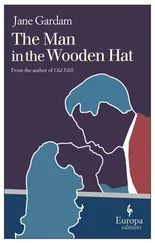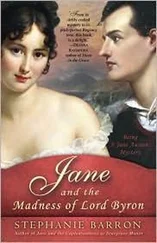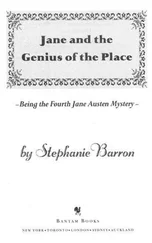Stephanie Barron - Jane and the Man of the Cloth
Здесь есть возможность читать онлайн «Stephanie Barron - Jane and the Man of the Cloth» весь текст электронной книги совершенно бесплатно (целиком полную версию без сокращений). В некоторых случаях можно слушать аудио, скачать через торрент в формате fb2 и присутствует краткое содержание. Жанр: Исторический детектив, Иронический детектив, на английском языке. Описание произведения, (предисловие) а так же отзывы посетителей доступны на портале библиотеки ЛибКат.
- Название:Jane and the Man of the Cloth
- Автор:
- Жанр:
- Год:неизвестен
- ISBN:нет данных
- Рейтинг книги:3 / 5. Голосов: 1
-
Избранное:Добавить в избранное
- Отзывы:
-
Ваша оценка:
- 60
- 1
- 2
- 3
- 4
- 5
Jane and the Man of the Cloth: краткое содержание, описание и аннотация
Предлагаем к чтению аннотацию, описание, краткое содержание или предисловие (зависит от того, что написал сам автор книги «Jane and the Man of the Cloth»). Если вы не нашли необходимую информацию о книге — напишите в комментариях, мы постараемся отыскать её.
Jane and the Man of the Cloth — читать онлайн бесплатно полную книгу (весь текст) целиком
Ниже представлен текст книги, разбитый по страницам. Система сохранения места последней прочитанной страницы, позволяет с удобством читать онлайн бесплатно книгу «Jane and the Man of the Cloth», без необходимости каждый раз заново искать на чём Вы остановились. Поставьте закладку, и сможете в любой момент перейти на страницу, на которой закончили чтение.
Интервал:
Закладка:
19
A tyger was a small boy arrayed in livery, almost as a mascot, whom the fashionable set employed to ride on the exterior of their carriages. — Editor's note.
20
These words, slightly modified and expanded, make up Austen's principal description of Lyme Regis in her final novel, Persuasion. — Editor's note.
21
Named after Captain Francis Negus, this was a warm punch made of water, sugar, and sherry or port, and frequently offered at balls. — Editor's note.
22
The Royal Navy was divided into three squadrons — the Red, the White, and the Blue. Austen's brother Frank, for example, advanced to become Admiral of the Red, before his promotion to Admiral of the Fleet at the age of 89. — Editor's note.
23
Mathew Barnewall was at this time only a claimant to the viscountcy of Kingsland, and his right to that tide and inheritance was not yet determined by the House of Lords. It is unlikely that Jane Austen was aware of this dispute when she met the Bamewalls. — Editor's note.
24
Crawford is speaking of James, Duke of Monmouth, the bastard son of Charles I, who sailed from France to Lyme in 1685, intent upon toppling his uncle James II from the throne of England. His revolt was suppressed, and twelve men of Lyme were hanged on gibbets erected in the shallows of the beach where Monmouth landed. — Editor's note.
25
“The Monster” was the common appellation for Napoleon Buonaparte. Captain Fielding probably alludes to the seventeen-month-long British, Russian, and Neapolitan blockade of French forces holding Malta in 1799. The final French surrender in March of that year was marked by a daring escape attempt on the part of Admiral Denis Decres, who barely survived to be named Napoleon's Naval Minister in 1801. The nearly 1000 men on his ship, the Guillaume Tell, were hardly so fortunate; Decres gave up his opportunity to escape in order to attack the British fleet single-handedly, and lost 500 men under fire. Badly wounded himself, he was taken prisoner and released after the Treaty of Amiens in 1801. Presumably, Captain Fielding lost his leg in the midst of Decree's attack. — Editor's note.
26
The Peace of Amiens, negotiated in October 1801 and broken in May 1803, brought peace to France and England only briefly. A year later, in May 1804, Napoleon crowned himself emperor of France, and hostilities between the two countries continued until 1815. — Editor's note.
27
Captain Fielding here refers to the Earl of Westmoreland and his family, resident in Bristol but controlling Lyme's two parliamentary seats through corrupt voting practices. The Fanes dominated Lyme for roughly a century — from the 1730s until the Reform Act of 1832, when the borough was reduced to one MP. In 1867 it was disenfranchised completely. (See John Fowles, A Short History of Lyme Regis, Little, Brown & Co., 1982.) — Editors note.
28
If one can judge by the appearance of Austen's extant manuscripts — Sanditon, for example — she made a habit of writing on small sheets of folded paper, which could be readily hidden if a visitor intruded upon her privacy. These sheets were then assembled in book form, and the pages hand-sewn through at the fold. It would appear she is speaking here of her unfinished work, The Watsons, which Austen scholars believe she began sometime in 1804. The manuscript paper bears an 1803 watermark. — Editors note.
29
Cassandra was engaged in 1795 to marry the Reverend Thomas Craven Fowle, son of the Austens lifelong friends, and a protege of Lord Craven, whose naval expedition to the West Indies Fowle felt obligated to join that same year. He died of yellow fever in San Domingo in February 1797, aged 29. He left Cassandra a legacy of one thousand pounds. She never married. — Editor's note.
30
This conversation with Cassandra regarding marriage must have impressed Jane, because it eventually found its way, in amended form, into The Watsons manuscript. — Editors note.
31
Only intimates of the family were accustomed to visit before noon, while acquaintances usually paid calls before dinner. — Editors note.
32
A barouche was considered quite fancy in the first part of the nineteenth century. It had two seats facing each other, and held four people comfortably; the landau top folded back in the middle, to make it an open carriage often used for country outings. It was drawn by anywhere from two to six horses. — Editor's note.
33
Captain Fielding probably refers to the relative newness of the roads. Lyme was inaccessible to wheeled traffic until 1759, when a turnpike was built leading into the town; all land transportation prior to that date was done by pack horse. — Editors note.
34
In die presence of several members of an untitled family, it was customary to address the eldest child by the tide Miss, or Mister, with younger siblings distinguished by the tide and their first names. Thus the ordering of rank was preserved; similarly, the eldest would pass in and out of the room before die next youngest child in age, and so on to the youngest. — Editor's note.
35
Surgeons were considered common village tradesmen rather than educated professionals, such as physicians, and their wives could not be presented at Court, while physicians' wives could. — Editor's note.
36
In her letter to Cassandra, written from Lyme Sept 14, 1804, Austen refers to Miss Armstrong without revealing her Christian name; in another letter dated April 21, 1805, she mentions renewing the acquaintance in Bath. We learn here for the first time that Miss Armstrong's name was Lucy. — Editor's note.
37
Jeremy Bentham (1748–1832) is best known as a wealthy lawyer of the Georgian period who advocated Utilitarianism: the belief that society should be regulated by inherent principles, much as his rough contemporary Adam Smith (1723–1790) believed economies operated by self-evident market forces. Chief among these principles was that social action should produce the “greatest good for the greatest number”—a frankly democratic notion. Bentham attracted a coterie of “philosophical radicals,” who, by 1815, advocated universal suffrage in England. Reverend Austen is referring here, however, to a famous passage from Bentham's 1789 work, Introduction to the Principles of Morals and legislation. — Editor's note.
38
Mr. Sidmouth is paraphrasing Kant The philosopher actually wrote that he was unable to find “any being capable of laying claim to the distinction of being the final end of creation.” (Critique of Judgment, 1790). — Editors note.
39
The search for fossils was well advanced along the Dorset coast by the time Austen visited it in 1804. A local schoolgirl, Mary Anning, would be credited with the discovery of the world's first ichthyosaur in the cliffs between Lyme and Charmouth in 1811, when she was just twelve years old. — Editor's note.
40
Ann Radcliffe Is best remembered for the Gothic romance, The Mysteries of Udolpho, which Austen satirized in Northanger Abbey. She was, along with her contemporaries Maria Edgeworth, Charlotte Smith, and Fanny Burney, one of the women novelists Austen read and admired. — Editor's note.
Читать дальшеИнтервал:
Закладка:
Похожие книги на «Jane and the Man of the Cloth»
Представляем Вашему вниманию похожие книги на «Jane and the Man of the Cloth» списком для выбора. Мы отобрали схожую по названию и смыслу литературу в надежде предоставить читателям больше вариантов отыскать новые, интересные, ещё непрочитанные произведения.
Обсуждение, отзывы о книге «Jane and the Man of the Cloth» и просто собственные мнения читателей. Оставьте ваши комментарии, напишите, что Вы думаете о произведении, его смысле или главных героях. Укажите что конкретно понравилось, а что нет, и почему Вы так считаете.












